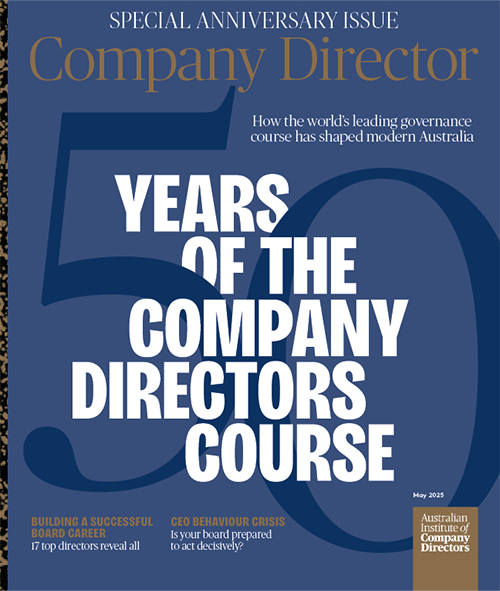We ask a prominent director to share three important lessons from three different professional experiences.
Rebecca Davies AO FAICD’s experience as a non-executive director and chair spans government, not-for-profit, health, research, church, music and financial services sectors. She is currently a director at the Heart Foundation and chair of its research advisory committee. She is also the deputy chair of MedTech Actuator, director and chair of the audit and risk committees for Defence Health and an advisory board member of the Catholic Development Fund. Previous board roles include Chris O’Brien Lifehouse, LCM Health Care and JDRF International and Australia.
Her career in law involved acting for high- profile Australian and international clients, with particular focus on technology, media and financial services.
The Board: JDRF International (rebranded as Breakthrough T1D) and Australia
The Lesson: Regularly review whether the board structure is fit for purpose
My daughter has Type 1 diabetes, which is why I got involved with JDRF. When I first joined JDRF Australia in the 1990s, it was a relatively new organisation with only one paid staff member. A few on the board were what you might call “the great and good”.
I never actually met them, because they didn’t attend board meetings.
These were high-profile people whose names were used on letterheads to lend status to the new organisation. That wouldn’t be acceptable today. It would be better to have those kinds of people as ambassadors or in a non-director role. Most people understand that being a director in title-only involves all the responsibilities without knowing what is going on.
It’s important for NFPs to regularly review whether their structure is fit for purpose. It means focusing on the purpose of the board, which will inevitably change over time. What worked at the start may not work in later years. Every couple of years, the board should take stock. Is the relationship between board and management an appropriate one? Have we got the right skills on the board?
JDRF International ended up with more than 40 board members. We realised it was too many people. It was not a straightforward process to assess the skills we had and what was needed for the future, but over a couple of years, we reduced the number to a more manageable level.
The Board: National Heart Foundation
The Lesson: Invest in building relationships
When I joined the National Heart Foundation in 2014, it was a federated body with state and territory bodies, and an overarching federal body. The state bodies were independent legal entities with their own boards and management.
I was the president of the Heart Foundation of NSW, therefore automatically on the board of the national organisation. It was obvious that this was a dysfunctional way of operating. Having multiple levels of management was inefficient and while it was good to have local community engagement, many things didn’t need duplication. We needed to ensure consistency in how we presented ourselves.
We had many conversations about becoming a national body. The decision had to be made at national, state and territory levels. For some on the national body there was a conflict because their state organisations didn’t want to merge. To get it across the line, and to help people overcome their natural reluctance to make change, required time and diplomacy.
The experience taught me logic will take you part of the way when you’re embarking on major change, but developing relationships is essential. You can’t just rely on external advisers or lawyers to be saying, “This is a great idea — this is how to do it.” You need to acknowledge that sometimes emotion and fear drives behaviour and plan how to overcome that.
The Board: LCM Health Care and Chris O’Brien Lifehouse
The Lesson: Never take financial viability for granted
When I went to my first LCM Health Care board meeting in 2008, I was shocked that the conversation was around solvency. I’d assumed that as part of the Catholic church, it would never go broke. But a previous CEO had made a number of unprofitable acquisitions.
Not wanting to be involved in something that would go belly-up, I sought advice from a colleague, who thought, with the right discipline, the organisation would survive. With a lot of hard work, effective change, and a new CEO good at managing costs, we got it back on track.
It taught me you should never take anything for granted — particularly in the NFP space. Many are dependent on single sources of funding — and a decision can be made overnight to stop that funding.
A similar situation occurred while I was on the Chris O’Brien Lifehouse board. The government was unsure if the model would work. It was a completely private organisation, delivering services to public and private patients. For public patients, it relied on government funding. As directors, we had to hold our nerve, but keep a close watch on the finances.
This taught me not to assume because you’ve existed for decades, support will be ongoing. Directors must temper mission engagement with hard-headed business acumen. Government and donor priorities change — can we adapt to that change?
Latest news
Already a member?
Login to view this content



